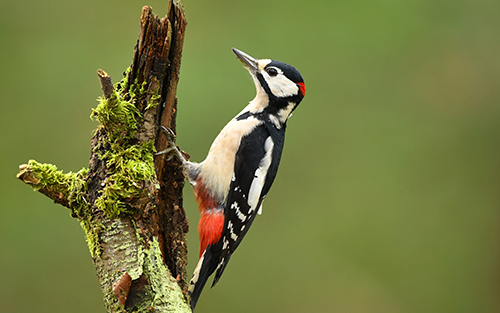- July 20, 2023
- News
Summary
Much like nails that are hammered into wood, the beaks of woodpeckers may get stuck upon impact. So, how do woodpeckers avoid the potential problem of having their beak stuck into trees?

July 13, 2023 - Repeated pecking into trees to excavate cavities and remove bark while searching for food is essential for many woodpecker species. However, much like nails that are hammered into wood, the beaks of woodpeckers may get stuck upon impact. So, how do woodpeckers avoid the potential problem of having their beak stuck into trees? That is a question a team of researchers at the University of Antwerp (Antwerpen, Belgium) sought to answer by using Mikrotron 1.3 megapixel recording cameras to create slow-motion, high-resolution videos for kinematics analysis that uncovered previously unknown behaviors exhibited by black woodpeckers.
Deformation occurs whenever a sharp object penetrates a softer, porous and fibrous tissue such as wood. As a result, the wood will clamp around the penetrated sharp object and, when that object is being pulled back, exert shear forces that resist this movement. This is the way nails become firmly anchored after being hammered into wood. When this happens to the beak of a woodpecker, it strongly compromises the bird's pecking performance.
To conduct their study, the research team recorded high-speed videos of black woodpeckers (Dryocopus martius) in lateral view during pecking with the Mikrotron cameras set in an uncompressed 10-bit monochrome format. One woodpecker was filmed while pecking wood at a video frame rate of 500 frames per second and a resolution of 1280 x 1024 pixels. A second woodpecker was filmed at 1533 frames per second and 704 x 564 pixels. Out of many videos created, 10 beak retraction events were selected for in-depth analysis based on view perspective and image sharpness. Pixel coordinates of eight anatomical landmarks were tracked frame-by-frame with either XMAlab 1.5.5 or Progressive Tracker software.
Kinematic video analysis of the black woodpeckers showed how they manage to quickly withdraw their beaks, revealing a two-phase pattern. First, a few degrees of beak-tip-down rotation about the nasofrontal hinge causes the tip of the upper beak to be retruded while its proximal end is lifted. Next, the head is lifted, causing beak-tip-up rotation about the nasofrontal hinge while the lower beak starts retruding and initiates the final freeing.
The team concluded that these consecutive actions facilitate beak retraction by exploiting the presumably low frictional resistance between the upper and lower beak keratin surfaces, allowing them to slide past each other. It also demonstrates the counter-intuitive value of maintaining cranial kinesis in a species adapted to deliver forceful impacts. This suggests that efficiently dealing with stuck beaks is important for the successful execution of bouts of short-interval pecks, normally about 20 pecks per second. During this process, the woodpeckers make extensive use of cranial kinesis.
In conclusion, by relying on the Mikrotron camera, the University of Antwerp researchers quantified the kinematics of a previously unknown behavior by the black woodpecker in response to a stuck beak: a quick succession of upper and lower beak retraction facilitating the release of the beak.
About Mikrotron, a brand of SVS-Vistek GmbH
SVS-Vistek GmbH acquired 100% of the shares of Mikrotron GmbH with retroactive effect from 01 January 2022. Through this integrative merger of the two companies under the umbrella of TKH Vision, the two companies combine their strengths and competencies and place their camera expertise on a strong entrepreneurial basis.
Now a brand of SVS-Vistek, Mikrotron is internationally renowned for small and particularly robust high-speed cameras in the industrial image processing market. Digital high-speed cameras have outstanding technical performance characteristics and are widely used in industrial and scientific applications as well as in the field of sports, advertising and by nature filmmakers.
Did you enjoy this great article?
Check out our free e-newsletters to read more great articles..
Subscribe

